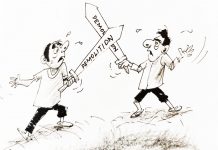
Have you ever wondered why children now have a hard time putting their gadgets aside, even if their parents, ate, and kuya are telling them to do something? Are you surprised that the majority of people can spend long hours manipulating their cell phones instead of attending to worthwhile tasks? Well, it’s not just the trend nowadays; it’s the result of people’s confusion in determining which is real and which is not.
The boundary between reality and virtual phenomena is increasingly blurred, ushering in an era where distinguishing between the two becomes daunting. As technology advances, we find ourselves immersed in virtual worlds that mimic reality with astonishing accuracy, while reality becomes augmented by digital overlays. This merging of realms has tremendous implications, challenging our perceptions of what is real and what is not and redefining our understanding of intelligence, be it human or artificial.
At the heart of this merging lies the exponential growth of virtual reality (VR) and augmented reality (AR) technologies. These immersive experiences transport users to alternate worlds where they can interact with virtual objects and characters as if they were tangible entities. With the advent of increasingly sophisticated VR and AR devices, the line between the physical and the virtual becomes increasingly blurry, leading to a seamless integration of the two realms.
The rise of artificial intelligence (AI) further complicates this merging of realities. AI systems are becoming increasingly adept at mimicking human behavior and cognition, blurring the line between pure intelligence and artificial intelligence. AI can analyze vast amounts of data, make predictions, and even engage in creative tasks previously thought to be exclusive to human intellect. As AI continues to evolve, distinguishing between human and artificial intelligence becomes a tough challenge.
This convergence of realities has significant implications for society as a whole. On one hand, it opens up unprecedented opportunities for innovation and exploration, allowing us to push the boundaries of creativity and imagination. On the other hand, it raises ethical concerns regarding privacy, identity, and the manipulation of reality. As virtual and augmented experiences become indistinguishable from reality, the potential for misinformation and manipulation grows, posing significant challenges for individuals and societies alike.
The merging of reality and virtual phenomena erases traditional boundaries in fields such as entertainment, education, and communication. Virtual classrooms, for example, allow students to engage with educational content in immersive ways, transcending the limitations of traditional learning environments. Similarly, virtual concerts and events bring people together from around the world, creating shared experiences that defy physical distances.
In this rapidly evolving landscape, individuals should develop critical thinking skills and digital literacy to grapple with the complexities of merged realities. By taking note of the mechanisms behind virtual and augmented experiences, as well as the capabilities and limitations of AI, we can harness the potential of these technologies while safeguarding against their misuse.
This development represents a paradigm shift in how we perceive and interact with the world around us. As boundaries dissolve and distinctions blur, we are challenged to reconsider our notions of reality, intelligence, and human experience. We have the opportunity to shape a future where the boundaries between the physical and the virtual become increasingly fluid, opening up new possibilities for exploration, discovery, and connection.



